
 |
|||||
|
|
|||||
|
|
|
|||||
|
|
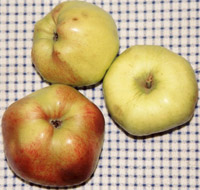 |
COX'S POMONA Cox’s Pomona was introduced around 1825 by the same Richard Cox of Colnbrook Lawn, near Slough, Buckinghamshire, who raised Cox’s Orange Pippin. It was described by Bunyard as a handsome culinary apple, with medium/large yellow fruit, heavily streaked with crimson. The flesh is white and melting and breaks down when cooked. Though it has some acidity it needs little sugar. It can also be eaten as a dessert apple, being crisp and juicy if eaten fresh, and more mellow flavoured when it ripens. Snowy white blossom. Good crops. It supposedly grows well in cooler soils. Middle/late season, lasting to December. Poll 5 |
||
|
||||
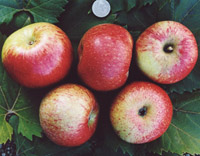 |
CRAWLEY
BEAUTY A handsome apple discovered by Cheal's Nursery (now under
Gatwick Airport) at Crawley, in a cottage garden in Sussex around 1870.
A late culinary/dessert apple with crisp, juicy flesh, which cooks to
a lightly flavoured purée. It may be stored until February. The
spreading trees will flower relatively late in spring and so are more
reliable for setting fruit in the cold districts. Heavy cropping and said
to be resistant to scab and canker. Free spurring. Pollination Group 8 |
|||
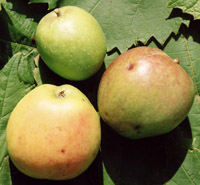 |
CREMIERE
An old, late season, medium sized, bittersweet cider apple from Somerset,
though the name suggests it might originally have been French. Crisp,
sweet and quite pleasantly flavoured, with mild tannin, when eaten raw.
It was recorded in the report of the Apple and Pear Conference of 1934
for the first and only time, seemingly lost in this country since then.
A hard apple, initially, when ripe in late September, it stores well and
stays juicy into the New Year and is useful for cider makers who want
to blend it with other apples which are ripe at different times, from
October to December. It is a reliable and consistent cropper here. We
rediscovered it at Grove Research Station, Tasmania, and it returned to
Britain in 2005. Pollination Group 5 |
|||
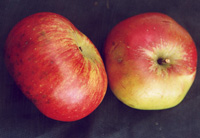 |
CRIMSON BRAMLEY A bud sport of Bramley's Seedling, which originated in an orchard at Southwell, Nottinghamshire, before 1913. It differs only from Bramley’s Seedling in having a crimson blush and broader crimson streaks over the skin. Ripe in November and storing until March. Vigorous, part tip bearing. T. Pollination Group 4 | |||
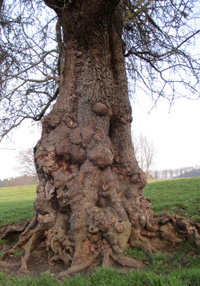 |
CROXDALE
CRAB Croxdale Hall and Estate, just south of Durham City, dates
from the 15th century or earlier. There is a 12th century church in the
grounds. In open pasture called North Park is the most magnicifent and
very, very old apple tree. It is probably a crab, though the young growth
and foliage are not typical and it might have some mixed parentage with
Malus Domestica. We have not seen the mature fruit, but we include it
here because of the tree and not the fruit. Public access is available
and Denis Gregson, an Arboricultural Officer with a local council and
a great lover of trees visited it regularly over many years and told us
of it, sending photos and cuttings to graft here. The size is immense,
the trunk is hollow, heavily knarled and open in part, so one can see
right through it. The girth is perhaps the greatest we have come across.
In Spring it is a mass of blossom. A truly impressive tree of antiquity
and mystery. We look forward to learning more of its fruit, though the
tree itself is the star. Thanks to Denis Gregson for this and reports
of other apple trees. |
|||
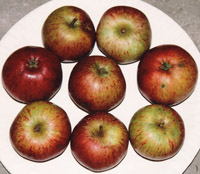 |
DABINETT An old bittersweet cider variety supposedly found by Mr Willian Dabinett in a hedge, as a wild seedling, near Middle Lambrook, Somerset. It is still popular and well known. According to Bulmer’s Pomona it originated in the Martock/Kingsbury area of Somerset. It has been said to be a seedling of Chisel Jersey. A prolific, regular and precocious bearer with medium sized conical apples, greenish yellow, flushed and striped red. The apples are ripe from the end of October to mid-November. The flesh is fragrant, very sweet and moderately astringent. Still favoured for cider blends and also as a single variety cider apple. It has been said by some to be self-fertile, but it is best not to rely upon this. It will last until the end of the year when it starts to shrink. The trees do not grow large, but are very productive. Pollination Group 6 | |||
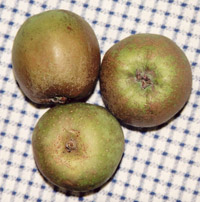 |
D'ARCY
SPICE An old late dessert apple found in the gardens of The Hall,
Tolleshunt d'Arcy, near Colchester, around 1785. Known as D'Arcy Spice,
or the Spice Apple, until 1848, when it was introduced by a nurseryman
John Harris as Baddow Pippin. Still popular in Essex. Greenish gold fruit,
with some russeting and with a spicy nutmeg flavour. The crisp and juicy
fruit is best after a warm summer. It was formerly said to store until
May, but warmer summers and winters now make this unlikely. It is said
to prefer lighter soils, but the rootstock takes care of the soil, not
the variety. Partially tip bearing. Large flowers. Pollination Group 4 |
|||
DANCER’S
DELIGHT Colin Dancer owns Windmill Farm at Quainton, Buckinghamshire,
as have his ancestors, and like most ancient farms it comes with an orchard
of old trees. It also comes with a magnificent, still working, windmill.
Against the orchard is a very sunken green lane, eroded by the toil of
endless carts that have brought grain and carried flour away, in ages
past. There are three, possibly four apple trees there that have unmatched
DNA and this one has been named by Mr Dancer. Ripe in October, it has
a matt surface with russet at the stalk and in some years the russet can
be quite extensive in patches and nets. Small to medium sized and round
to conical, the skin is pale green often with a splash of pink on top.
The flesh is very sweet and well flavoured for eating, but with quite
lively acid and a strong lemon aftertaste. Pollination Group 4 |
||||
| DEANS´ CODLIN A large cooking apple, known in the first half of the 19th century and described by Hogg in the 5th edition of his ‘The Fruit Manual’ (1884) as “a first-rate kitchen apple”. It was introduced by nurseryman, Mr W. Deans, of Jedburgh, Roxburghshire, Scotland. A very large fruit, slightly taller than wide, with prominent ribs on the sides, which form ridges around the eye. The skin is deep yellow, dotted with large russet specks. The flesh is yellowish, 'tender and pleasantly flavoured'. It is in season throughout winter, until February. Barron, the author of the report of the National Apple Congress, at Chiswick, in 1883, assumed that samples exhibited from two sources as Deans’ Codlin, were the same as Potts’ Seedling. His judgements were sometimes questionable. Deans’ Codlin was next noted in England, when exhibited from France at the 1934 Apple and Pear Conference, at Wisley. There do not appear to be any records of it having been grown in Britain since the 19th century, but it still existed in collections in Switzerland and Romania. In 2019 we received scions from Matthias Buchta, in Bavaria, Germany, and it is now back in Britain. Pollination Group 5 | ||||
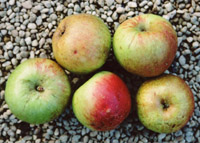 |
DECIO
Known in Italy as Melo D'Ezio. It probably dates back to 450 A.D., and
was named after the Roman general Ezio, who marched northwards to fight
Attila the Hun, supposedly taking the apple with him. A small, sweet and
fruity dessert apple, flushed red, and popular in Italy for hundreds of
years. Ripe in October, it stores until March. A good, but not a great
apple. Very upright habit of growth. Pollination Group 5 |
|||
|
||||